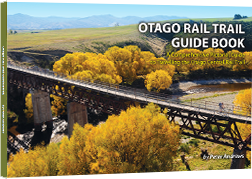- Home
-
Places
-
On the Trail
- Clyde (Population: 1,200)
- Alexandra ( 5,510)
- Chatto Creek ( 11)
- Omakau ( 400)
- Lauder ( 12)
- Oturehua ( 27)
- Wedderburn ( 47)
- Ranfurly ( 663)
- Waipiata ( 24)
- Kokonga ( 5)
- Hyde ( 21)
- Middlemarch ( 300)
Journeys on the Trail (152 km)- Clyde - Alexandra (8km)
- Alexandra - Chatto Creek (17 km )
- Chatto Creek - Omakau (12 km)
- Omakau - Lauder (7 km)
- Lauder - Oturehua (23 km)
- Oturehua - Wedderburn (12 km)
- Wedderburn - Ranfurly (13 km)
- Ranfurly - Waipiata (8 km)
- Waipiata - Kokonga (10.5 km)
- Kokonga - Hyde (14.5 km )
- Hyde - Middlemarch (27 km)
Near the Trail- Ophir (48)
- Becks (15)
- Poolburn ()
- St Bathans (6)
- Naseby (120)
- Danseys Pass (7)
- Kyeburn (4)
- Patearoa (60)
- Macraes Flat (40)
Off the Trail- Queenstown (28,224)
- Mosgiel (6,708 - Closest town from Dunedin Airport)
- Dunedin (120,246)
-
- Activities
- Accommodation
- Food & Drink
- Operators
- Self Planning Guide
- Other Info






















